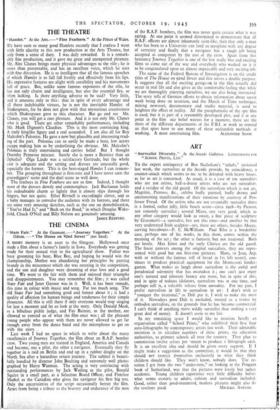ART
"Surrealist Diversity." At the Arcade Galleries. LITHOGRAPHS FOR "SCHOOL PRINTS, LTD."
To the expert astringency of Ben Nicholson's "reliefs," reviewed last week, the surrealists at the Arcade provide, by coincidence, a counter-attack which seems to me to 'be defeated with heavy losses, as far as art is concerned. As usual, it is a case of ten surrealists who are not artists, half-a-dozen artists who are not surrealists, and a residue of the old guard. Of the surrealism which is not art, Magritte, Penrose, &c., exhibit badly painted, badly drawn and uninteresting manifestations of their emotions by courtesy of Pro- fessor Freud. Of the artists who are not essentially surrealist there is a formal, rather jolly, little beach scene—circa 19213—by Picasso, not remotely surrealist ; several Miros, one very good, which in any other category would look as sweet, a fine piece of sculpture by Giacometti—a surrealist, but not this time—and another by that very underrated Irish sculptor—yes, there are others, besides Moore, carving hereabouts—F. E. McWilliam. Paul Klee is a borderline case, perhaps one of his works, in this show, comes within the meaning of the act ; the other is fantastic but not irrational. Both are lovely. Max Ernst and the early Chirico are the old guard. The finest painters among the original surrealists, they are repre- sented with good but not first-rate pictures. Hans, or Jean, Arp, with or without the famous roll of bread in his left nostril, con- tinues to produce practical equipment for the Montessori kinder- garten. What makes us laugh about surrealism is the awful and paradoxical solemnity that has overtaken it ; one can't just enjoy one's natural and inherent lunacy any more, but in spite of this, and in spite of tedious idolators, surrealism was at one time, and perhaps still is, a valuable release from unreality. For my part, I prefer surrealism in life to surrealism in art: I don't wish to "conquer the irrational," as Dali put it, I wish to make the most of it. Nowadays poor Dali is excluded, treated as a traitor by orthodox surrealists, on the grounds that he has become commercial. I can't think of anything more wildly surrealist than making a very great deal of money. It doesn't seem to me fair.
In my remaining space I would like to mention briefly an organisation called "School Prints," who exhibited their first four auto-lithographs by contemporary artists last week. Their admirable intention is to circulate numbers of these prints, via education authorities, to primary schools all over the country. They plan to commission twelve artists per -nnum to produce a lithograph each. It is an excellent idea and should be given every support. If I might make a suggestion to the committee, it would be that they should not restrict themselves exclusively to what they think children should like. They won't know, nobody does. The re- action I got from the two "under-tens," on looking at the Penguin book of Sutherland, was that the pictures were lovely but rather academic. Young children experience very little difficulty before what seems esoteric to adults, cubism and surrealism included. Good, rather than good-mannered, modern pictures might also do


























 Previous page
Previous page